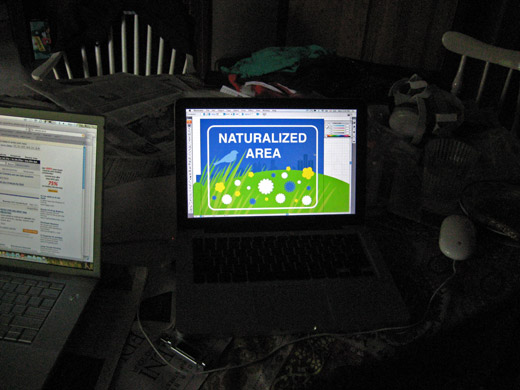
Spent the day with Steven and Danielle doing some shopping and design. Details to follow.

Spent the day with Steven and Danielle doing some shopping and design. Details to follow.
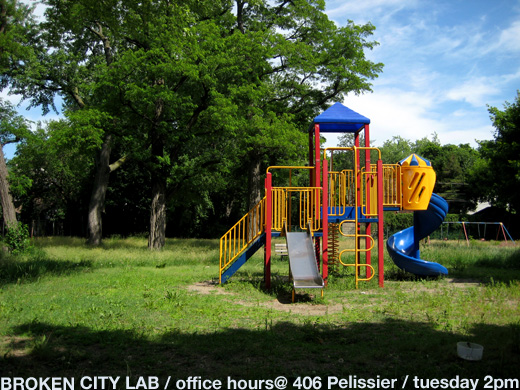
Broken City Lab office hours return on Tuesday, July 14th, at 2pm, at 406 Pelissier. Come play with us. We’ll be working on some ongoing projects and starting to plan for the fall!
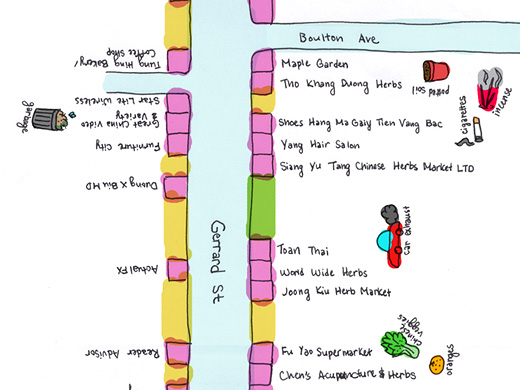
This is a small excerpt of a large map made by students in OCAD’s Cities for People summer workshop, depicting the East Chinatown neighbourhood, its businesses and their smells.
You should take a look at the larger map, which helps to demonstrate the potential in mapping outside of the continually pervasive Google Maps.
To take time to note a neighbourhood in this somewhat peculiar detail is an interestingly necessary method for interfacing with a place one might normally walk by, and in turn, of course, makes me eager to do the same somewhere around these parts.
[via Spacing]
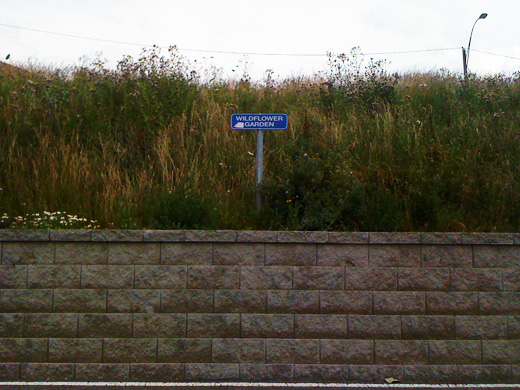
Another walk along the riverfront today, this time with Andrew and Barb from Render / DodoLab. Windsor’s meadows are looking incredible, and if this strike ends it’ll be quite disappointing to see so many patches of long grasses and wildflowers cut down.
I can understand that there was a point at which people could have thought that things looked “messy,” but I think we’re well past that now. Windsor is now into a full-on prairie meadow stage and it’s gorgeous.
So, this sign, and this area pictured above, is as the sign says, a Wildflower Garden. It’s official, it was made official by that simple blue sign on a galvanized pole. So, if all it takes is a sign, why don’t we make official some other prime Windsor meadow locations and reclaim some space for “naturalized areas.” I’m going to be on the look out for particularly great locations to formalize as Windsor’s naturalized meadows.
Or if signs aren’t your thing, but you still want to work with these amazingly wondrous meadows, head out with Leesa Bringas at 8am every morning for some grass braiding.
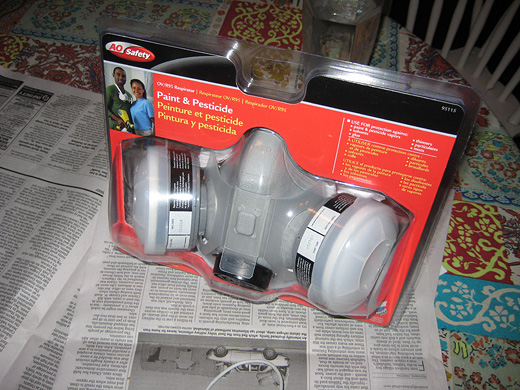
As recommended by Jodi, I now have a respirator that specializes in protection against: paint & pesticide vapors, solvents, glue, thinners, particulates, and mists.
There’s still a ways to go with preparing the planters, but hopefully by next week we’ll be able to start planting.
In other news, an awesome brainstorming night with Cristina—so many great things being planned for the coming months!!!
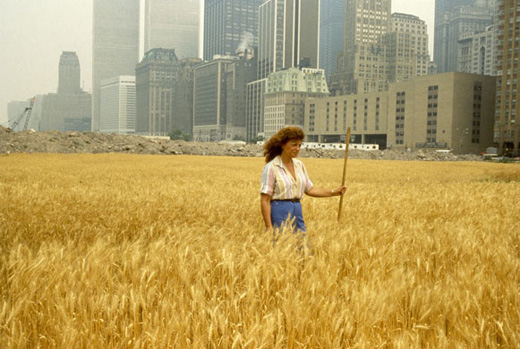
From Green Museum:
One of the early pioneers of both the environmental art movement and Conceptual art, Agnes Denes brings her wide ranging interests in the physical and social sciences, mathematics, philosophy, linguistics, poetry and music to her delicate drawings, books and monumental artworks around the globe.
In 1982, she carried out what has become one of the best-known environmental art projects when she planted a two-acre field of wheat in a vacant lot in downtown Manhattan. Titled,Wheatfield — A Confrontation, the artwork yielded 1,000 lbs. of wheat in the middle of New York City to comment on “human values and misplaced priorities”. The harvested grain then traveled to 28 cities worldwide in “The International Art Show for the End of World Hunger” and was symbolically planted around the globe.
Imagine turning some the vast wasteland areas in the city (read any vacant big box store parking lot, Brighton Beach, EC Row Expressway) into a wheat field, or a meadow, or maybe more importantly, imagine having a year to make a project at this scale.
[via we make money not art]
httpv://www.youtube.com/watch?v=xZkf44jysYw
I like public art that does something. I like thinking about architectural works as art and about the potential for viewing city layouts as art and so, I like art that exists as something more than art.
Marcus Vergette‘s Time and Tide Bell is an early-warning system of sorts for the rising tide that will inevitably be the outcome of climate change. The work involves a newly invented bell form, which allows multiple tones to be struck in one structure, so as the tide rises, the bell’s clapper is moved to strike the bell. As the tide rises, the bell will ring more often, but will also become further submerged.
Watching the video above is kind of strange—it shows the first strike of the bell in the water. As people clap and as the bell rings again, it’s strange to think that there is art like this to be made. This bell appears to be the first of other bells that can be installed in other communities, and in some capacity, created with consultation with that community about the inscription on and tone of the bell.
Of course, I’ve now begun to wonder what a public work that would demarcate something very distinct to now, or very distinct to the place we’re heading that could be installed in Windsor. If there was something you could leave for someone to see well into a post-apocalyptic future, what would it be? I think I’d want to say, “I’m sorry.”
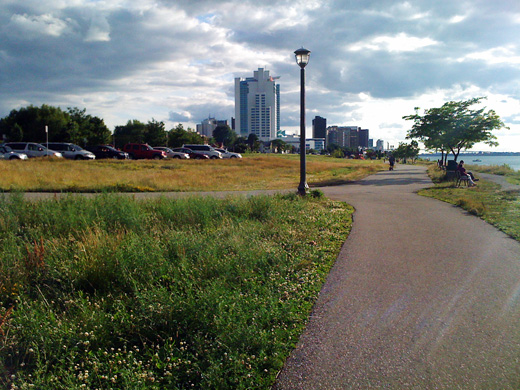
A year ago today, the first post was made on BrokenCityLab.org – Broken City Lab is Alive.
Last night, Josh and I went for a walk and we thought, for a moment, we were in a real city. On our walk, we saw that there were people out walking, riding bicycles, enjoying the view alongside meadows and wildflower gardens, the downtown streets were shutdown and open to pedestrians to walk and sit outside of bars and restaurants without the traffic. For a few hours last night, the city didn’t seem quite so broken.
The post that I made a year ago had a picture that, for me, kind of summarized the general sense of the city for a lot of people. I’m not sure that anything has changed, and in all likelihood, things are worse than ever, but last night I had a feeling of hope for the city that I haven’t felt for a while.
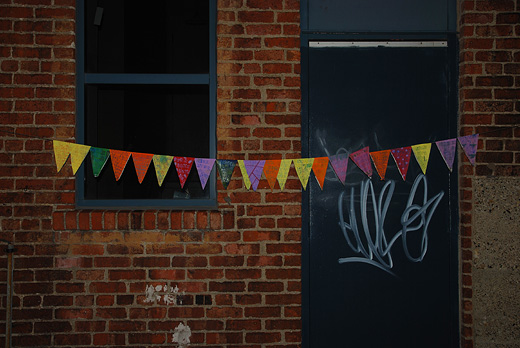
An random chance to catch up with Laura, Sam, and some other folks I hadn’t seen for a while turned into this quick intervention.
As part of their OH! C.N.A.P. fun, they had made a lot of bunting for another party they had to attend, but it seemed too great to not temporarily put up somewhere in the city. So, in the alley next to Phog, the bunting was quickly strung up with the help of staples (after some difficulties with the wind), and really was an great example of what’s possible with some paper, yarn, and a amazing group of people.
Check out more photos of the process at Laura and Sam‘s flickr sets, or check out Sam’s tutorial on making the bunting, should you be so inclined to take up a similar project.
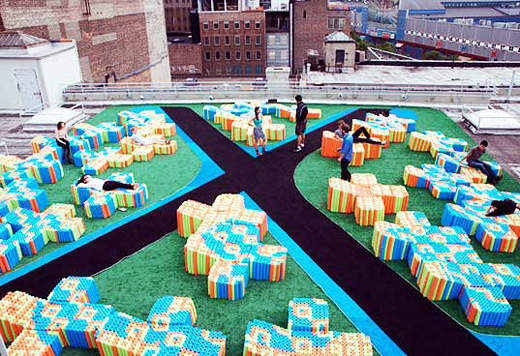
Pool noodles and an empty roof can make for some amazingly bright alternatives to tar.
The rooftop space, designed by INABA will be used for video screenings and community events, with the grouped pool noodles used as modular seating, all of which makes me all the more anxious to imagine all the potentially great alternative uses to the top floor of those three downtown parking garages.
[via Inhabitat]